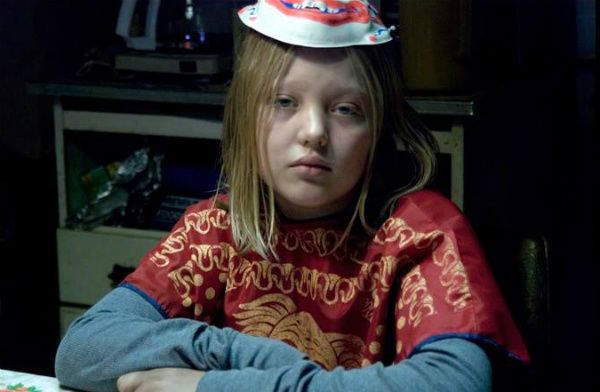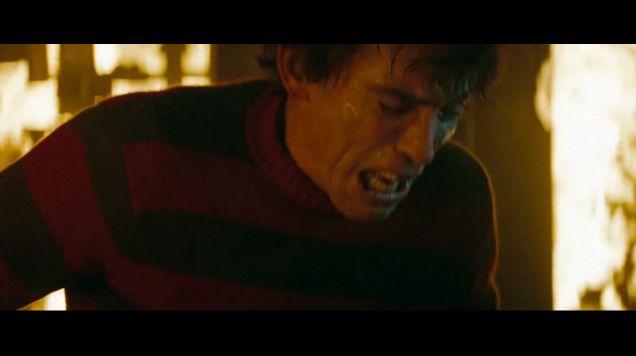 Not sure what I'm talking about? Well, here are a couple examples. Let's start with Michael Myers from Halloween. I will admit I've never seen the original to completion, but I know enough to gather that this towering, silent antagonist has intimidated and haunted many devoted horror fans. The thing that made him memorable and frightening was his emotionless face/mask and the fact he killed his family at a young age with no explanation. He is a supernatural force that appears to be unkillable and very few know what he looks like behind the mask. In the tragic retelling of Halloween by Rob Zombie, we get to experience the stereotypical broken home Michael lives in. His mother works late night hours as a stripper, his mother's boyfriend is an abusive jerk, and his older sister is simply rude and possibly out of control, like those teens you would see on Maury. As we follow young Michael, we sympathize with his living situation and bullying he puts up with in school, but the movie tugs its audience back and forth between sympathy, concern, and fear. He displays signs of psychopathic behavior, yet audiences could connect this behavior to his unfortunate and unpleasant surroundings. Aside from an unsympathetic protagonist and other terrible characters Michael encounters in the sanitorium, we lack fear in his future violent actions.
Not sure what I'm talking about? Well, here are a couple examples. Let's start with Michael Myers from Halloween. I will admit I've never seen the original to completion, but I know enough to gather that this towering, silent antagonist has intimidated and haunted many devoted horror fans. The thing that made him memorable and frightening was his emotionless face/mask and the fact he killed his family at a young age with no explanation. He is a supernatural force that appears to be unkillable and very few know what he looks like behind the mask. In the tragic retelling of Halloween by Rob Zombie, we get to experience the stereotypical broken home Michael lives in. His mother works late night hours as a stripper, his mother's boyfriend is an abusive jerk, and his older sister is simply rude and possibly out of control, like those teens you would see on Maury. As we follow young Michael, we sympathize with his living situation and bullying he puts up with in school, but the movie tugs its audience back and forth between sympathy, concern, and fear. He displays signs of psychopathic behavior, yet audiences could connect this behavior to his unfortunate and unpleasant surroundings. Aside from an unsympathetic protagonist and other terrible characters Michael encounters in the sanitorium, we lack fear in his future violent actions. Next is a villain I thought was safe from the dreaded remakes, A Nightmare on Elm Street's Freddy Krueger. Although the original touched on Freddy's backstory, it was quite brief and told by Nancy's mother. Freddy murdered children and was never prosecuted by the authorities, so the parents took action by burning him alive. In the remake, they show Freddy as an innocent school janitor that happened to be close to the children and, at first, show that the parents burned him alive without too much explanation. When the end is near, it was revealed that there was questionable evidence that Freddy molested the parents' children. The difference between the original and the remake pertain to the parents' actions. In the original, they informed the authorities of the murders. They didn't bother reporting Freddy's molestation actions in the remake. Although Freddy isn't completely portrayed as a sympathic character, the structure of the story makes you believe Freddy is a nice guy, if you're unfamiliar with the original, and that he was wrongfully executed especially with the flashbacks the teenagers have of him. The details put into the backstory gives us way too many emotions for Freddy aside from fear among other "creative" choices, like showing his face right off the bat as opposed to the original's decision to shadow his appearance.
Next is a villain I thought was safe from the dreaded remakes, A Nightmare on Elm Street's Freddy Krueger. Although the original touched on Freddy's backstory, it was quite brief and told by Nancy's mother. Freddy murdered children and was never prosecuted by the authorities, so the parents took action by burning him alive. In the remake, they show Freddy as an innocent school janitor that happened to be close to the children and, at first, show that the parents burned him alive without too much explanation. When the end is near, it was revealed that there was questionable evidence that Freddy molested the parents' children. The difference between the original and the remake pertain to the parents' actions. In the original, they informed the authorities of the murders. They didn't bother reporting Freddy's molestation actions in the remake. Although Freddy isn't completely portrayed as a sympathic character, the structure of the story makes you believe Freddy is a nice guy, if you're unfamiliar with the original, and that he was wrongfully executed especially with the flashbacks the teenagers have of him. The details put into the backstory gives us way too many emotions for Freddy aside from fear among other "creative" choices, like showing his face right off the bat as opposed to the original's decision to shadow his appearance.In short, don't give us a backstory, especially a stereotypical broken home, bullying, lover's tragedy for our iconic horror villains. The fear that haunts us about them is the unknown and everyone knows that humans cannot handle the unknown very well. It makes us uncomfortable and even paranoid.

No comments:
Post a Comment